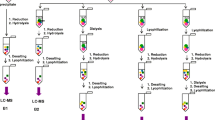Abstract
The amino acids lysine and glycine are reported to react with glucose at physiological pH and temperature and undergo non-enzymic glycation. Three other amino acids present in relatively larger amounts in the lens i.e. alanine, aspartic acid and glutamic acid were also found to undergo non-enzymic glycation as found by incorporation of uniformly labelled (U-[14C]) glucose into the amino acids. The glucose incorporation was 1.6 to 2.5% for alanine, 35 to 50% for aspartic acid and 2.3 to 3.3% for glutamic acid. Each amino acid of varying concentrations lowered the extent ofin vitro glycation of lens proteins significantly in glucose-treated homogenates of normal lens from humans. The decrease in glycation for alanine was between 32 and 69%, that for aspartate was between 18 and 74%, and for glutamate was between 52 to 74%. Decreased glycation was greater for higher concentrations of glucose. Scavenging of intracellular glucose and decreasing the extent of glycation of lens proteins could be the mechanism of action by which the amino acids alanine, aspartic acid and glutamic acid could exercise a beneficial effect on cataract and diabetic retinopathy.
Similar content being viewed by others
References
Adams RE (1990) InYear Book of Ophthalmology. pp. 1–6. St Louis, USA: Mosby Year Books.
Ramakrishnan S (1992) Indian Eye Research group meeting. L.V. Prasad Eye Institute, Hyderabad January 1992 (reference available on request).
Ramakrishnan S, Sulochana KN (1993)Exp Eye Res 57: 623–28.
Harding JJ (1991)Current Opin Ophthalmol 2: 3–15.
Harding JJ (1992) InCataract, Biochemistry, Epidemiology and Pharmacology. pp. 140–7. London, New York: Chapman and Hall.
Miyata S, Monnier V (1992)J Clin Invest 89: 1102–12.
Moses RA, Hart WM (1987)Adler's Physiology of the Eye. Clinical application. 8th Ed, p. 227. St. Louis: The C.V. Mosby Company.
Berman ER (1991)Biochemistry of the Eye. pp. 204. New York: Plenum Press.
Ramakrishnan S (1992)Essentials of Biochemistry for Students of Dentistry, Nursing, Pharmacy, Ophthalmology and Ocular Biochemistry. p. 26. India: Annamalai University (reference available on request).
Ramakrishnan S, Sulochana KN (1993)Insight 11: 30–31.
Swamy MS, Abraham EC (1989).Invest Ophthalmol Vis Sci 30: 1120–26.
Blakytny R, Harding JJ (1992)Exp Eye Res 54: 509–18.
Blakytny R, Harding JJ (1992)Biochem J 288: 303–7.
Ramakrishnan S, Sulochana KN, Arunagiri K, Dhanalakshmi NP (1994) Abs. 508 (S-156) XI International Congress of Eye Research, New Delhi, 1994.Exp Eye Res 59: suppl. 1.
Frank RN (1991)Ophthalmology 98: 586–93.
Author information
Authors and Affiliations
Rights and permissions
About this article
Cite this article
Ramakrishnan, S., Sulochana, K.N., Punitham, R. et al. Free alanine, aspartic acid, or glutamic acid reduce the glycation of human lens proteins. Glycoconjugate J 13, 519–523 (1996). https://doi.org/10.1007/BF00731438
Received:
Revised:
Issue Date:
DOI: https://doi.org/10.1007/BF00731438




